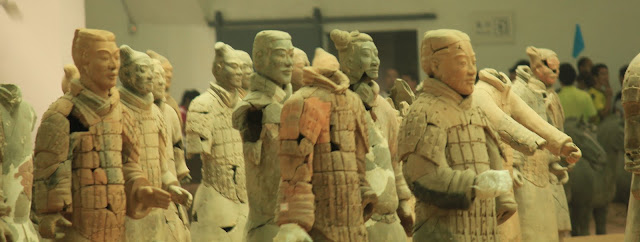The year is 246 BC and young Emperor Qin is a typical angsty teen. Anxious to make his mark on world history while impressing the ladiez, this 13 year-old orders some 700,000 workers to build 9,000 terra-cotta soldiers, horses, and chariots over 30 years. “Plus, think of the amazing tourist draw it’ll have in 2,200 years!” The kid had amazing foresight.
In the 1970s, farmers found a surprising number of clay shards in the soil they unearthed during their well-digging. The government swooped in and found Qin’s army spread among four buried pits. As it turns out, people who sought the overthrow of the Qin dynasty just years after the Emperor’s death stole weapons from the clay soldiers for the rebellion. In the process, the structures protecting the statues collapsed and shattered many of the soldiers.
But Emperor Qin had the last laugh. Over forty years, China has been rebuilding the army, piece by piece. Declared a UNESCO World Heritage Site in 1987, the collection has sold out museums tickets around the world and is considered a must-see attraction in China.
Which is why, with only one weekend left of her month stay, Kristin requested a visit to see Qin’s clay warriors.
While it was cool to see a quadrillion clay soldiers from a distance, we were… just... looking at clay soldiers from a distance (ok, so it’s pretty fancy that they’re super old).
But then this piqued my interest: it’s an active archeological site. As in, they’re still digging up pieces of clay and putting together these 3D puzzles.
The Warriors reside in the outskirts of Xi’an, and our lab mate + girlfriend served as guide during the weekend. Xi’an had a really pleasant feel about it. Hectic, yes, but just a tad slower than Beijing. And there were more trees (you know how I feel about trees). Also, the International Horticulture Exposition is taking place there, so we got to see its awesome mascot all over town
Its head is supposed to be a pomegranate, FYI.
There were other delightful characters, too.
Shaanxi, the province containing Xi’an, is home to many Chinese Muslims. There’s a large mosque in Xi’an that claims a pagoda as its minaret (!). We stepped inside just as sundown occurred, and as we are currently in Ramadan, we witnessed a bunch of people quickly scarf down some Chinese food to break their fast before heading in to prayer.
Outside the mosque is a (tourist) street market. And Tanu and I scored jawesome matching tshirts of pandas doing tai chi.
Not knowing how Chinese sizes run, I needed to try one on. So I found a welcoming alley.
The next morning we had baozi for breakfast (not surprising.)
Then we checked out the city wall. Xi’an is an ancient city that has taken turns with Beijing as China’s capital over the last few thousand years. As such, the walls were massive: up to 16m in thickness at the base and 12m tall. With a perimeter of ~9 miles, bike riding and even small bus tours take place. We just hiked up to the top and admired the surroundings (note: Xi’an also had lots of pollution/smog/humidity, so we could only admire a few blocks in each direction).
In addition to Xi’an being an ancient Chinese city, prehistoric people also inhabited the area. I think the oldest human fossil was found here? (idk. ask Kristin. or google). There’s an amazing museum that covers eons of human history including some beautiful Chinese artifacts and works of art. One interesting set of figurines was this:
Judging from the tri-tone coloring of the third statuette, I’d guess that these are from the Tang dynasty (look- I learned something!). They represent characters from the story “Journey to the West” (http://en.wikipedia.org/wiki/Journey_to_the_west) that describes the journey of the Buddhist monk Xuanzang who traveled to India to bring Buddhist scriptures to China.
As it turns out, this story is a fictionalized version of true events. In fact, the emperor at the time rewarded the monk by building the Wild Goose Pagoda in his honor, which also housed the scriptures.
Our birds-eye view from the top:
We had just enough time to grab something to eat before we took the overnight train back to Beijing, and several convenient eateries were nearby.
just say no!
Finally, we found a hot pot place. It was our hot pot experience! For those of you who don’t know, hot pot is where they bring a boiling broth/soup to your table and then you put all sorts of raw veggies and meat in there to cook. It was delicious! …but 100% contained meat (Kristin acted like she didn’t like eating meat-tainted veggies. But she was just looking for an excuse to bend the rules.)
raw cow stomach!
the spread.
We spent way too much time eating, so getting back to the train was very eventful. But we made it! And we made a friend on the train who eventually fell asleep after being a rambunctious 4 year-old.




















No comments:
Post a Comment